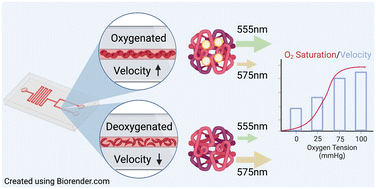Simultaneous quantification of blood rheology and oxygen saturation to evaluate affinity-modifying therapies in sickle cell disease†
Abstract
Sickle cell blood demonstrates oxygen-dependent flow behavior as a result of HbS polymerization during hypoxia, and these rheological changes provide a biophysical metric that can be used to quantify the pathological behavior of the blood. Relating these rheological changes directly to hemoglobin oxygen saturation would improve our understanding of SCD pathogenesis and the potential effects of therapeutic drugs. Towards this end, we have developed a microfluidic platform capable of spectrophotometric quantification of Hb-O2 saturation and simultaneous evaluation of the accompanying rheological changes in SCD blood flow. We demonstrated the ability to measure changes in Hb-O2 affinity and a restoration of oxygen-independent blood flow behavior after incubation with voxelotor, an oxygen affinity modifying drug approved for use in SCD. We also identified regimes in Hb-O2 saturation where the effects of HbS polymerization begin to take effect in contributing to pathological flow behavior, independent of voxelotor treatment. In contrast, incubation with voxelotor recovered oxygen-dependent blood flow over a range of PO2, providing a framework for understanding voxelotor's therapeutic effect in lowering the PO2 at which the requisite Hb-O2 saturation is reached to observe pathological blood flow. These results help explain the mechanistic effects of voxelotor and show the potential of this platform to identify affinity-modifying compounds and evaluate their therapeutic effect on blood flow.



 Please wait while we load your content...
Please wait while we load your content...
